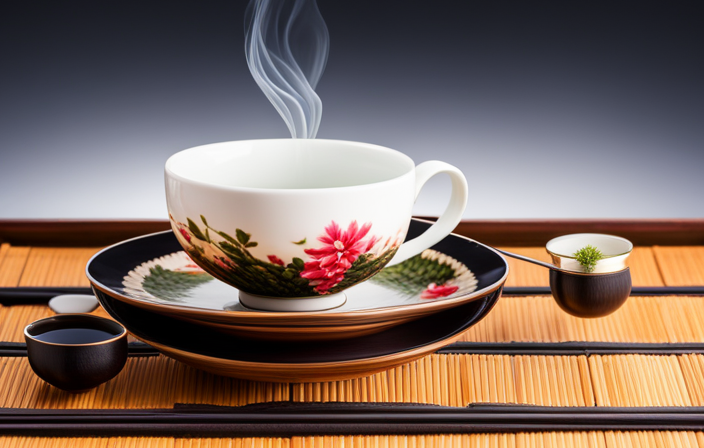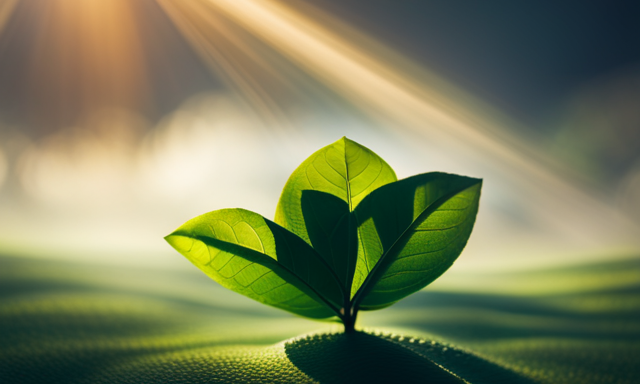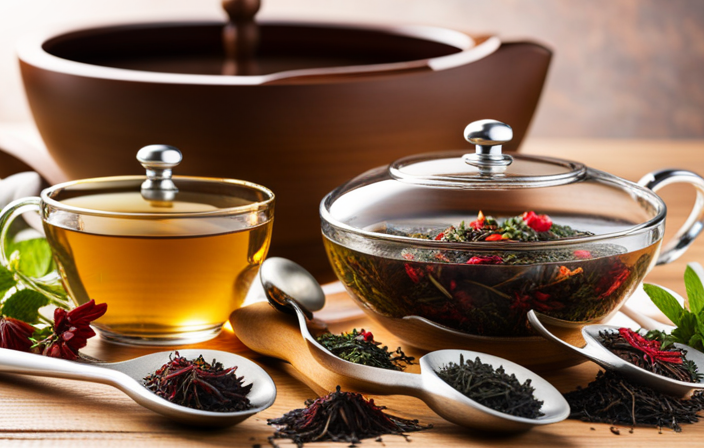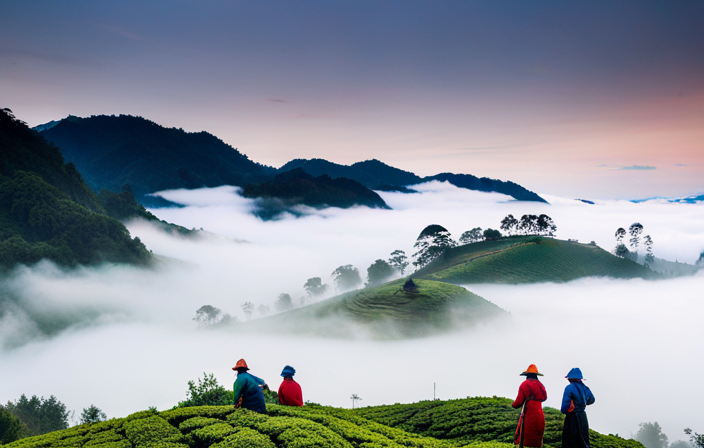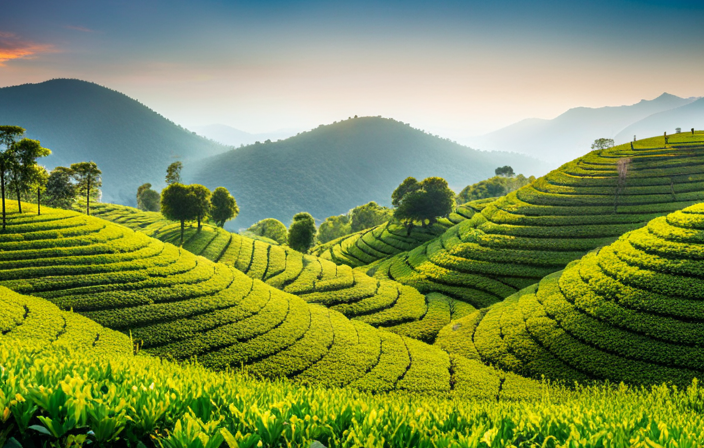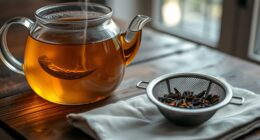Enter the captivating realm of a classic tea ceremony, where history and tranquility come together.
Join me as we explore 12 intriguing aspects of this ancient ritual, from its origins in China to the philosophical connection with Zen Buddhism.
Discover the masterful performance of the tea master, the aesthetic beauty of tea utensils, and the symbolism behind the tea ceremony kimono.
Immerse yourself in the harmony, respect, purity, and tranquility that define this timeless practice.
Let’s embark on this journey together.
Key Takeaways
- The tea ceremony originated from ancient Chinese customs and practices during the Tang dynasty and evolved as a way to honor and appreciate the beauty and simplicity of tea.
- The tea master plays a pivotal role in orchestrating the ceremony, ensuring every aspect runs smoothly and serving as a conduit for connection, mindfulness, and tranquility.
- Tea bowls hold cultural significance in the Japanese tea ceremony, reflecting natural elements of Japanese culture and bringing together history, culture, and the art of tea.
- Designing tranquil tea spaces and incorporating elements of peaceful ambiance, such as natural materials, soft lighting, and gentle sounds, are crucial for creating a serene atmosphere during the tea ceremony.
Origins in China: Tracing the Tea Ceremony’s Roots
I’m fascinated by the tea ceremony’s origins in China and how it traces back to ancient traditions. Chinese tea traditions have a rich and extensive history, dating back thousands of years. The tea ceremony, as we know it today, evolved from these ancient customs and practices.
It was during the Tang dynasty that tea became a popular beverage, and the art of serving and enjoying tea began to take shape. The ceremony itself became a way to honor and appreciate the beauty and simplicity of tea. It wasn’t just about the act of drinking tea, but also about creating a harmonious and mindful experience.
This deep respect for tea and its traditions laid the foundation for the philosophy that would later be explored in the connection between tea and Zen. As we delve into the next section, we’ll uncover the profound philosophical influences that tea and Zen have on each other.
Tea and Zen: Exploring the Philosophical Connection
Sometimes, the interplay between tea and Zen creates a profound and enlightening philosophical connection. The practice of meditation and the appreciation of tea share a common emphasis on mindfulness and presence in the moment. In the realm of tea, this connection is beautifully expressed through the art of the traditional Japanese tea ceremony, also known as Chanoyu. The ceremony embodies the principles of zen aesthetics, with its simplicity, harmony, and reverence for nature. The table below highlights some key aspects of the tea ceremony and its relation to zen philosophy:
| Aspect | Tea Ceremony | Zen Philosophy |
|---|---|---|
| Focus | Attention to every detail of preparation and presentation | Cultivating awareness and being fully present |
| Simplicity | Minimalist utensils and decorations | Embracing simplicity and eliminating unnecessary distractions |
| Harmony | Balance between host, guest, and the environment | Seeking harmony within oneself and with the world |
| Transience | Appreciating the fleeting nature of the tea experience | Embracing impermanence and the ephemeral nature of life |
Together, tea and Zen offer a profound way to cultivate mindfulness, find inner peace, and connect with the present moment. The ritual of preparing and enjoying tea becomes a pathway to self-discovery and a deeper understanding of the interconnectedness of all things.
The Role of the Tea Master: A Masterful Performance
During the tea ceremony, the tea master orchestrates a beautiful and intricate performance, showcasing their expertise and creating a mesmerizing experience for the guests. The tea master’s role is pivotal in ensuring that every aspect of the ceremony runs smoothly and flawlessly.
Their artistry in performance goes beyond simply preparing and serving tea; it encompasses a deep understanding of the tea’s history, the various utensils used, and the art of conversation. The tea master’s every movement is deliberate and precise, from the way they handle the tea whisk to the way they pour the tea into delicate cups.
Their performance is a delicate balance of grace and precision, captivating the guests and immersing them in the rich tradition of the tea ceremony. Through their artistry, the tea master not only serves tea but also serves as a conduit for connection, mindfulness, and tranquility.
Tea Utensils: Aesthetic Beauty and Functionality
My favorite tea utensil is the tea bowl, as its aesthetic beauty and functionality enhance the overall tea ceremony experience. Tea bowls have a rich historical significance and cultural symbolism in the Japanese tea ceremony. These bowls are often handcrafted, each one unique in its design and glaze. The shape and size of the bowl play a crucial role in how the tea is prepared and served.
The wide and shallow bowls, called ‘chawan,’ are commonly used for whisking matcha tea, while deeper bowls, known as ‘yunomi,’ are used for steeping sencha or other loose-leaf teas. The intricate patterns and colors on the tea bowls reflect the natural elements of Japanese culture, such as the seasons or landscapes.
The tea bowl, with its delicate beauty and practicality, serves as a vessel that brings together history, culture, and the art of tea. Now, let’s delve into the different Japanese tea varieties, from matcha to sencha.
Japanese Tea Varieties: From Matcha to Sencha
When it comes to Japanese tea varieties, two names stand out: Matcha and Sencha.
Matcha, a powdered green tea, is known for its vibrant color and rich umami flavor.
Sencha, on the other hand, is a steamed green tea with a refreshing taste and a grassy aroma.
Both teas offer unique health benefits, such as antioxidants and potential weight management support.
Additionally, they hold cultural significance in Japan, being an integral part of traditional tea ceremonies and everyday life.
Let’s explore the differences between Matcha and Sencha, their health benefits, and the cultural importance they hold.
Matcha Vs Sencha
I love the rich, vibrant flavor of matcha, but sencha offers a refreshing, grassy taste that I also enjoy.
Matcha, a powdered green tea, is made from shade-grown tea leaves that are carefully ground to a fine powder. It’s known for its intense, umami flavor and is traditionally used in the Japanese tea ceremony.
Sencha, on the other hand, is a steamed green tea made from the leaves of the Camellia sinensis plant. It has a bright, grassy flavor and is a popular everyday tea in Japan.
Both matcha and sencha have their unique characteristics and are loved by tea enthusiasts around the world.
In a traditional tea ceremony, different tea varieties are used to create a harmonious experience, with each tea bringing its own distinct flavors and aromas. The tea ceremony techniques, such as the precise whisking of matcha or the steeping of sencha, further enhance the sensory experience and create a sense of mindfulness and tranquility.
Whether you prefer the boldness of matcha or the refreshing taste of sencha, both teas offer a delightful journey into the world of Japanese tea.
Health Benefits
Drinking matcha and sencha can have numerous health benefits, such as boosting immunity and promoting relaxation. Here are three key aspects of these teas that contribute to their positive effects on our well-being:
-
Rich in antioxidants: Matcha and sencha are packed with catechins, a type of antioxidant that helps protect our cells from damage caused by free radicals. This boosts our immune system, making us less susceptible to illnesses.
-
Calming effects: Matcha contains L-theanine, an amino acid that promotes relaxation and mental clarity. It helps reduce stress and anxiety, allowing us to stay focused and productive throughout the day.
-
Detoxification: Both matcha and sencha have natural detoxifying properties. They help cleanse our body by eliminating toxins and promoting healthy digestion. This leads to improved overall well-being and a revitalized feeling.
Incorporating matcha and sencha into our daily routine can be a simple yet impactful way to support our health and enhance our overall quality of life.
Cultural Significance
Exploring the cultural significance of Japanese tea varieties, from matcha to sencha, reveals the rich traditions and customs surrounding these cherished beverages. Japanese tea ceremonies hold a deep cultural symbolism, representing harmony, respect, and tranquility. Each tea variety carries its own unique significance, showcasing the diverse flavors and aromas that have been perfected over centuries.
The tea ceremony itself is a mindfulness practice, emphasizing being fully present in the moment and appreciating the beauty in simplicity. From the precise preparation of the tea to the graceful movements of the host, every aspect of the ceremony is carefully choreographed to create a serene and meditative atmosphere.
Tea isn’t just a beverage in Japanese culture; it’s a way of life, a symbol of hospitality, and a means of connecting with others. The act of serving tea is seen as an expression of kindness and warmth. Through the rituals and customs associated with Japanese tea, one can delve into the rich cultural heritage and appreciate the artistry and grace that surrounds this cherished tradition.
The Tea Room: Creating an Atmosphere of Tranquility
When it comes to creating an atmosphere of tranquility in a tea room, attention to design is paramount. From the choice of materials to the layout of the space, every element is carefully considered to cultivate a sense of peace and harmony.
The use of natural materials like wood and stone, soft lighting, and minimalistic decor all contribute to a serene ambiance that allows guests to fully immerse themselves in the tea ceremony experience.
Designing Serene Tea Spaces
I love the idea of incorporating two large windows in my tea room, allowing ample natural light to create a serene atmosphere. It’s amazing how something as simple as sunlight can transform a space and enhance the overall ambiance of a tea room.
Here are three reasons why I believe these windows are essential in tea room design:
-
Connection to Nature: The large windows will provide a direct view of the surrounding natural beauty, bringing the outside in and creating a harmonious connection with nature. This connection is vital in creating a tranquil and serene atmosphere for tea enthusiasts.
-
Natural Lighting: The abundance of natural light that will flood the tea room won’t only make the space feel brighter and more spacious but also uplift the mood of anyone inside. Natural lighting has a calming effect on our senses, making it perfect for enjoying a peaceful tea experience.
-
Visual Delight: The play of light and shadows through the windows will create a visually captivating experience. The interplay of sunlight filtering through leaves or reflecting off a nearby water feature will add depth and beauty to the tea room, enhancing the overall ambiance and creating a serene and inviting space for tea lovers.
Elements of Peaceful Ambiance
Something that can contribute to a peaceful ambiance in the tea room is the combination of soft music playing in the background and the gentle sound of water flowing from a small fountain.
Designing tranquil spaces involves considering every aspect that can enhance the experience of those seeking solace and relaxation. The soothing melodies of classical music or the gentle sounds of nature can create a calming atmosphere that allows one to disconnect from the outside world and embrace the present moment.
Furthermore, the sound of water flowing from a small fountain adds a touch of serenity and tranquility to the tea room, creating a meditative environment that fosters introspection and inner peace. These elements not only complement the visual aesthetics of the space but also contribute to the overall sensory experience of the tea ceremony.
Transitioning into the subsequent section about cultivating tranquil tea environments, let’s explore the significance of lighting and aromas in creating a serene atmosphere.
Cultivating Tranquil Tea Environments
To cultivate tranquil tea environments, one must carefully consider the lighting and aromas in the tea room.
1) Soft, warm lighting creates a soothing atmosphere, allowing guests to relax and focus on the present moment. Dimmed lights with soft hues promote a sense of calmness and tranquility.
2) Aromas play a crucial role in cultivating mindfulness and promoting relaxation. Delicate scents of fresh flowers or aromatic herbs can transport guests to a state of serenity.
3) Natural light streaming through windows can also enhance the tea experience, connecting guests to the outside world and creating a harmonious balance between nature and the tea room.
The Tea House Architecture: Traditional Design Elements
I love how the traditional tea house architecture incorporates natural elements like wood and stone to create a serene and harmonious atmosphere. The design of a tea house is rooted in the principles of Zen Buddhism, aiming to create a space that promotes tranquility and mindfulness. Let’s take a closer look at the architectural elements that make a tea house truly special:
| Element | Description | Purpose |
|---|---|---|
| Shoji (Sliding Doors) | Made of translucent paper and wooden frames, these doors allow soft natural light to filter through, creating a gentle and calming ambiance. | Enhances the connection between the interior and exterior, symbolizing the impermanence of life. |
| Tatami (Flooring) | Made of woven straw, tatami mats provide a soft and comfortable surface for guests to sit on. | Represents the traditional Japanese lifestyle and promotes a sense of humility and simplicity. |
| Engawa (Veranda) | A narrow wooden platform that surrounds the tea house, offering a peaceful view of the garden. | Provides a seamless transition between the interior and exterior, allowing guests to appreciate the beauty of nature. |
The tea house architecture, with its use of natural materials and thoughtful design, creates an environment that encourages reflection and introspection. It is through this serene setting that the art of the tea ceremony can truly come to life. Now let’s explore the next aspect of the tea ceremony: the art of graceful gestures.
Tea Ceremony Etiquette: The Art of Graceful Gestures
One must master the art of graceful gestures to fully appreciate the beauty and tranquility of a tea ceremony. Tea ceremony gestures aren’t mere motions; they carry deep meaning and symbolism, reflecting the essence of Japanese culture. Here are three significant gestures that are essential to the tea ceremony:
-
Bowing: The act of bowing before entering the tea room signifies respect and humility towards the host, the tea, and the ceremony itself. It sets the tone for the entire experience and creates an atmosphere of reverence.
-
Pouring tea: The delicate and precise movements involved in pouring tea demonstrate the host’s skill and attention to detail. Each pour is intentional and signifies the act of serving and nourishing others, embodying the spirit of hospitality.
-
Receiving and sipping tea: When receiving the tea cup, one should hold it with both hands, expressing gratitude for the offering. Sipping the tea slowly and appreciating its taste showcases mindfulness and the ability to find joy in simple pleasures.
Understanding and respecting these tea ceremony gestures is crucial to fully immerse oneself in this time-honored tradition.
Now, let’s explore the four principles of chanoyu: harmony, respect, purity, and tranquility.
The Four Principles of Chanoyu: Harmony, Respect, Purity, and Tranquility
The Four Principles of Chanoyu, which are Harmony, Respect, Purity, and Tranquility, form the foundation of a traditional Japanese tea ceremony.
Harmony emphasizes the importance of creating a peaceful and balanced environment, both internally and externally.
Respect is shown towards the tea utensils, the tea master, and the guests, fostering a sense of gratitude and appreciation.
Purity represents the cleanliness of the mind, body, and space, allowing for a clear and focused experience.
Lastly, Tranquility encourages a serene and calm mindset, enabling participants to fully immerse themselves in the present moment.
These principles guide every aspect of the tea ceremony, creating a deeply meaningful and meditative experience.
Importance of Harmony
There are four essential principles that guide the traditional tea ceremony, and harmony is the most important one. In the context of the tea ceremony, harmony refers to achieving inner balance and tranquility through the practice of mindfulness. Here are three intriguing aspects that highlight the importance of harmony:
-
Mindful Preparation: Before the ceremony begins, every detail is carefully considered and meticulously prepared. From the selection of tea leaves to the arrangement of utensils, each step is carried out with utmost mindfulness. This attention to detail helps create a harmonious environment.
-
The Ritual of Sharing: The tea ceremony isn’t just about the act of preparing and drinking tea; it’s a shared experience. The host and guests come together in harmony, engaging in respectful conversation and enjoying each other’s company. Through this communal experience, harmony is fostered and strengthened.
-
The Zen Influence: The tea ceremony is deeply rooted in Zen philosophy, which emphasizes the importance of mindfulness and being fully present in the moment. By practicing mindfulness during the tea ceremony, participants cultivate inner balance and tranquility, leading to a harmonious state of mind.
Significance of Respect
I have always found it fascinating how the practice of respect in the tea ceremony cultivates a sense of harmony and tranquility.
Cultural customs play a significant role in shaping the tea ceremony, with respect being one of the core values upheld. When participants engage in the ritual, they show reverence towards each other, the tea utensils, and the tea itself. This deep level of respect creates an atmosphere of mutual understanding and appreciation, fostering a sense of unity and tranquility.
Symbolism in rituals is also evident in the tea ceremony. For example, the act of serving tea isn’t just about quenching thirst but is a gesture of hospitality, friendship, and gratitude. The careful attention to detail and the intentional movements during the ceremony symbolize mindfulness, discipline, and the pursuit of inner peace.
Essence of Tranquility
Experiencing the essence of tranquility in a tea ceremony is a remarkable journey of finding inner peace and harmony. The art of tea ceremony, also known as ‘chanoyu,’ has been practiced in Japan for centuries and holds deep cultural significance.
Here are three intriguing aspects of a traditional tea ceremony:
-
Mindful Preparation: The tea ceremony begins with meticulous preparation, from cleansing the utensils to selecting the perfect tea leaves. This process cultivates a sense of mindfulness, encouraging participants to be fully present in the moment.
-
Harmonious Rituals: Every movement in a tea ceremony is deliberate and meaningful. From the graceful gestures of the host to the appreciation of the tea itself, each action is performed with utmost precision, fostering a sense of tranquility and harmony.
-
Reflective Contemplation: The tea ceremony provides a space for introspection and contemplation. As one savors each sip of tea, they’re encouraged to let go of distractions and immerse themselves in the present moment, fostering a deep connection with oneself and cultivating inner peace.
Tea Ceremony Kimono: Symbolism in Traditional Attire
Wearing a beautifully embroidered kimono during the tea ceremony truly enhances the cultural significance. Symbolism in attire is a crucial aspect of traditional clothing, and the kimono serves as a powerful symbol in the tea ceremony.
The intricate patterns and colors of the kimono reflect the season and the host’s taste, creating a harmonious connection with nature. The layers and folds of the kimono also represent modesty and humility, aligning with the values of the tea ceremony.
Furthermore, the kimono’s shape and design allow for graceful movements, emphasizing the elegance and grace of the participants. As I don the kimono, I feel a deep sense of respect for the tea ceremony’s rich history and the Zen influence it embodies.
With the kimono as a symbolic representation, I’m ready to explore the various rituals that make the tea ceremony a truly captivating experience.
Tea Ceremony Rituals: From Bowing to Pouring
As I observe the tea ceremony rituals, from bowing to pouring, I’m amazed by the precision and grace with which each movement is executed. It’s a true testament to the centuries of tradition and reverence that surround this ancient practice.
The tea ceremony isn’t just about the tea itself, but also about the careful attention to every detail, including the decorations. Tea ceremony decorations play a significant role in creating an atmosphere of tranquility and harmony. From the delicate flower arrangements to the carefully chosen utensils, each item is thoughtfully selected to enhance the overall experience.
Symbolism also plays a crucial role in the tea ceremony. Everything from the placement of the tea bowl to the movements of the host has a deeper meaning, representing concepts such as respect, gratitude, and mindfulness.
The tea ceremony is truly a beautiful and profound art form that teaches us the importance of simplicity and service to others.
Tea Ceremony and Wabi-Sabi: Embracing Imperfection and Transience
I appreciate the tea ceremony’s emphasis on embracing imperfection and transience, as it allows for a deeper connection to the present moment. In the tea ceremony, the concept of wabi-sabi is central, which celebrates the beauty of imperfection, impermanence, and the natural cycle of life.
This philosophy encourages us to find beauty in the transient nature of things, recognizing that nothing is permanent and that imperfections can add character and authenticity to our experiences. When we embrace imperfection, we let go of the need for perfection and instead focus on the present moment, fostering a sense of mindfulness and gratitude.
Through this practice, we learn to appreciate the fleeting beauty that surrounds us, whether it’s the delicate aroma of tea or the fleeting bloom of cherry blossoms. Embracing imperfection and finding beauty in transience allows us to approach life with a sense of acceptance and appreciation, enriching both our tea ceremony experiences and our everyday lives.
Frequently Asked Questions
What Is the Significance of the Tea Ceremony in Chinese Culture?
The tea ceremony holds great significance in Chinese culture. It is not just a simple act of drinking tea, but a cultural symbol and a way to foster social interaction. Its historical origins and regional variations add to its intriguing nature.
How Do Tea and Zen Philosophy Intertwine in the Tea Ceremony?
Tea and mindfulness are inseparable in the tea ceremony. Zen meditation and tea go hand in hand, as both practices encourage being present in the moment and finding tranquility through the act of preparing and savoring tea.
What Are the Specific Responsibilities of a Tea Master During a Tea Ceremony?
As the tea master, my responsibilities during a tea ceremony are crucial. I must ensure the smooth flow of the ritual, from preparing the tea to serving it with grace. The importance of these rituals lies in creating a tranquil and meaningful experience for all participants.
What Are Some Unique and Beautiful Tea Utensils Used in the Tea Ceremony?
During a tea ceremony, the tea master uses various tea utensils that hold great cultural significance. These unique and beautiful tools, such as the chawan (tea bowl) and chasen (tea whisk), enhance the experience and reflect the artistry of the ceremony.
Are There Different Types of Japanese Tea Used in the Tea Ceremony, and if So, What Are Their Differences?
There are different types of Japanese tea used in the tea ceremony, each with its own unique characteristics. Matcha is a powdered green tea known for its rich flavor and vibrant green color, while sencha is a steamed green tea with a refreshing taste.
Conclusion
In conclusion, the traditional tea ceremony is a captivating blend of history, philosophy, and artistry. Its origins in China and influence from Zen Buddhism create a profound connection between the mind and the act of preparing and drinking tea.
The role of the tea master, the beauty of the tea utensils, and the symbolism of the tea ceremony kimono all contribute to the immersive experience.
By embracing imperfection and transience through the concept of wabi-sabi, the tea ceremony offers a profound lesson in finding beauty in the fleeting moments of life.

